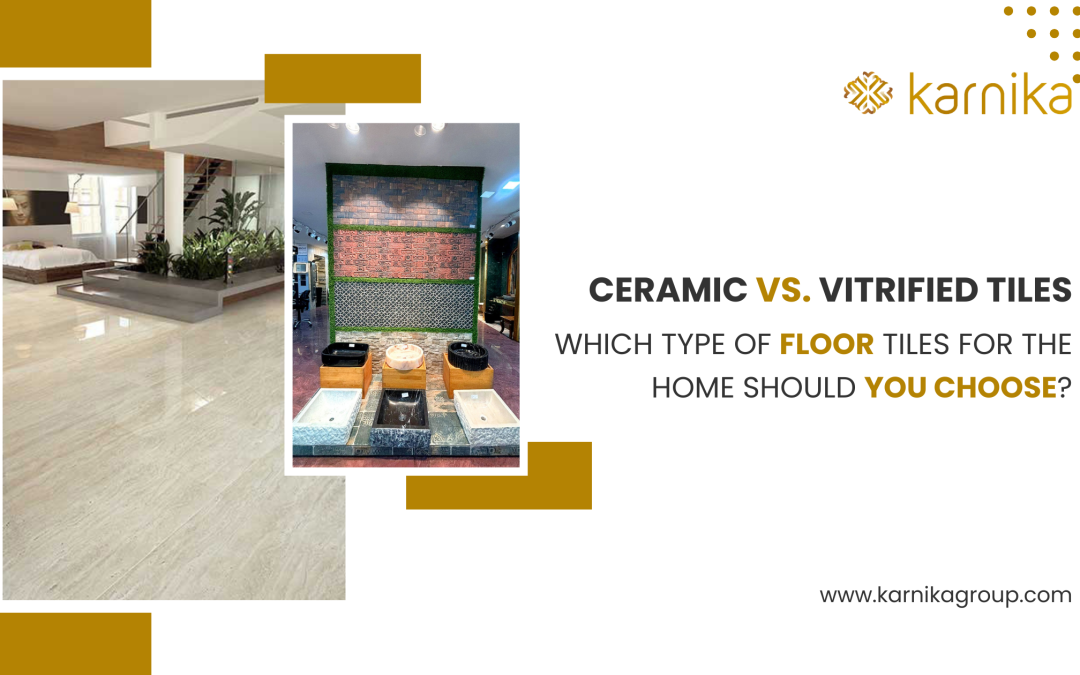Selecting the right tile design for your home is among the most crucial aspects. But, the biggest issue that might obstruct one’s selection process is choosing the right tile. The answer to this is simple, opt for the one that suits your needs and preferences the best.
Each tile has its unique properties and features that make it stand out from the rest. But, the ability to select the one that fits ideally with your home interior is a tough job. Thanks to the best dealers for floor tiles for homes, you can gather detailed insight into the differences between ceramic and vitrified tiles.
What are ceramic tiles?
These realistic, earthy-looking tiles are made from natural clay at a relatively low temperature. Such a manufacturing process creates tiles with low porosity, absorbing a bit of moisture but serving to the large-scale tile designs and finishes.
One can find ceramic tiles in a variety of colors, complementing every decor. From modern bathroom designs to country kitchen styles, these tiles are ideal for creating a sleek and minimalist interior.
What are vitrified tiles?
As the name goes, vitrified tiles undergo a process of vitrification. Created from a combination of silica, clay, and feldspar, these contribute to the strength and durability of the tiles. Vitrified floor tiles in Kolkata are highly resistant to water and give a more of a glass-like view.
These low-maintenance tiles are ideal for areas with high traffic inside the house. Commercial locations also prefer these to be an ideal alternative, compared to natural stones such as marble and granite, since they are less expensive.
Ceramic vs. Vitrified Tiles: What properties to look for?
Dealers of floor tiles for homes suggest both ceramic and vitrified tiles as ideal flooring for designing their interiors. Here are some properties that can help you understand their properties.
|
Parameters |
Ceramic Tiles |
Vitrified Tiles |
|
Composition and Manufacturing Properties |
These are made up of clay and water, pulverized into a fine substance. When exposed to high temperatures, this transforms into a kiln. |
These tiles on the other hand are made up of silica and clay, mixed in a ratio of 60:40. Heated at a high temperature, helps the tiles gain its glossy appearance. |
|
Strength and Durability properties |
Ceramic tiles comparatively have lesser strength and durability than those of vitrified tiles. |
Vitrified tiles are durable tiles. They have additional strength, along with a tough surface having a strong composition. |
|
Resistance properties |
Ceramic tiles are resistant to scratches and stains. However, they might require immediate attention in case there is a stain on the material, it has to be cleaned right away to avoid any further stains. |
The strong surface of vitrified tiles along with their composition makes it much more resistant to scratches and stains. |
|
Anti-slip properties |
The anti-slip properties of ceramic tiles are much more reliable, considering their coarse texture. Such a surface tends to be less slippery. |
Vitrified tiles have a glass-like glossy texture. Thus, there is a high chance for it to be slippery, especially in moist conditions. |
|
Water absorption properties |
The water absorption rate for ceramic tiles is around 3%. These are mildly water-absorbent and work best in areas that are exposed to moderate moisture. |
These tiles have a lesser water absorption rate which makes them less porous. |
Choosing floor tiles for the home: Here’s what you must know
Each of these floor types is ideal for your home. But, selecting the right floor tiles depends on your needs and preferences. Their benefits are what makes them perfect for different purposes. Let’s take a look at them.
1. Style and design:
If versatility is what you are looking for, ceramic tiles are your best preference. These can create a unique look for a given area. Vitrified floor tiles in Kolkata, on the other hand, offer more of a uniform look. Thus, if you are looking for a more luxurious space in your room without any added expenses, these tiles can be your best choice.
2. Installation:
Vitrified tiles can cover larger areas with minimal grout lines. Ceramics on the other hand are a softer material that makes cutting and fitting in a given space easier.
3. Enhanced home value:
Vitrified tiles are highly durable and retain their appearance over time. This is great if you want to consider the resale value of your home. Ceramic tiles also have a long lifespan but can show signs of wear in areas with heavy foot traffic.
Thus, if you want to choose the right tiles to meet your flooring requirements, this is the perfect guide for you. Considering household chores, personal style preferences, and budget, try choosing between the natural charm of ceramic tiles and the long-lasting durability of vitrified tiles, depending on what best fits your needs.

